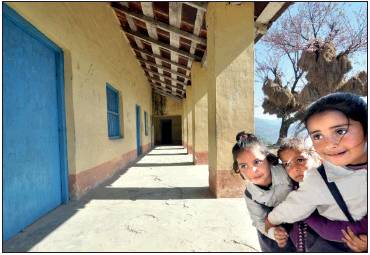Sanskrit in post-1947 India
(Created page with "{| class="wikitable" |- |colspan="0"|<div style="font-size:100%"> This is a collection of articles archived for the excellence of their content.<br/> Additional information ma...") |
|||
| Line 9: | Line 9: | ||
[[Category:India |S ]] | [[Category:India |S ]] | ||
[[Category:Education |S ]] | [[Category:Education |S ]] | ||
| + | [[Category:Languages-Scripts |S ]] | ||
=Uttarakhand= | =Uttarakhand= | ||
Revision as of 19:12, 19 November 2018
This is a collection of articles archived for the excellence of their content. |
Uttarakhand
2nd official language but few students/ 2018

From: Prashant Jha, Why Sanskrit schools are dying in the land where it’s an official language, November 17, 2018: The Times of India
Mukhem is a small village in the picturesque Tehri Garhwal district of Uttarakhand that is famous for two things — an ancient Nagaraja temple dedicated to the king of snakes, and a Sanskrit school established by the erstwhile maharaja of Tehri almost 80 years ago that was subsequently taken over by the state government. While the biennial fair held to honour Nagaraja still attracts thousands of devotees, the Rajkiya Sanskrit Vidyalaya is in a shambles and has not seen students for almost a decade.
But that’s the story with Sanskrit schools everywhere in the state, the only one in India to have declared Sanskrit as its second official language. According to records surveyed by TOI, as many as 54 of these schools do not have principals and 13 are without a single teacher. Of the approximately 350 sanctioned posts for teachers in these schools, 189 have been vacant for years.
With 90 such institutions, Uttarakhand has one of the highest numbers of Sanskrit schools in the country. An official in the state education department blamed “lack of opportunities” for the poor state of Sanskrit education. “Students have little scope after they pass out. Either they become priests or teachers. The government is also not hiring Sanskrit teachers, so their future remains bleak.” Many question the intent of the government in not appointing teachers to fill the vacancies. “For almost a decade now, even an independent director of Sanskrit education has not been appointed,” said Manoj Sharma, a Sanskrit teacher.
Old-timers in Mukhem said the Sanskrit school was one of four set up by the maharaja to ensure that the language lived. “After the government took over the school, no teacher was appointed here for several years, resulting in students dropping out,” said Nagendra Dutt Semwal, 75, a former priest of Nagaraja temple.
Villagers said things took a downward turn after 2006, when the school’s Sanskrit teacher left. Two years later, said the school’s caretaker Dwarika Prasad, two Hindi teachers were appointed in his place. “How could Hindi teachers have taught Sanskrit?” one villagers asked.
The school at present has no teachers and no students. And, while the principal of a local college has been given additional charge of the school, according to caretaker Prasad, he has “not visited the school even once”.
Meanwhile, the state government continues to spend almost Rs 4 lakh on the school annually in terms of the caretaker’s salary and the school’s maintenance.
Despite the sorry state of affairs, the Uttarakhand government recently announced that it will open nine more Sanskrit schools, two of which will be run in association with yoga guru Ramdev’s Patanjali group. Whether associating with the yoga guru will in any way bolster the state of Sanskrit schools is something only time can tell.